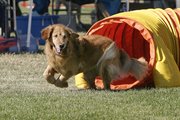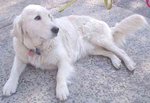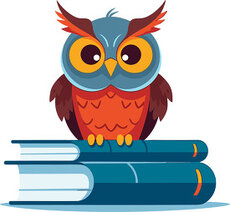Golden Retriever
|
|
| Golden Retriever | ||||||||||||||
|---|---|---|---|---|---|---|---|---|---|---|---|---|---|---|
| Common nickname | ||||||||||||||
| Golden | ||||||||||||||
| Country of origin | ||||||||||||||
| United Kingdom | ||||||||||||||
| Classification | ||||||||||||||
| ||||||||||||||
| Breed standards (external links) | ||||||||||||||
| FCI (http://www.google.com/search?q=cache:VFO9NaHYR2EJ:www.fci.be/uploaded_files/111gb99_en.doc+site:www.fci.be+%22111+/+29.+01.+1999%22&hl=en&ie=UTF-8), AKC (http://www.akc.org/breeds/golden_retriever/index.cfm), ANKC (http://www.ankc.aust.com/goldret.html), CKC (http://www.canadasguidetodogs.com/golden/goldenarticle1.htm) KC(UK) (http://www.the-kennel-club.org.uk/discoverdogs/gundog/g819.htm), NZKC (http://www.nzkc.org.nz/br320.html), UKC (http://www.ukcdogs.com/breeds/gundogs/goldenretriever.std.shtml) |
The Golden Retriever is a relatively modern and very popular breed of dog. It was developed as a retrieving dog to use while hunting wild fowl. Today it is one of the most common family dogs as it is easy to handle, very tolerant and does not require very much of the owners, other than regular exercise. It is often affectionately known as Golden, or Goldie.
| Contents |
Appearance
A Golden Retriever reaches its full height at about one year of age, and its full weight at about two. While it matures physically at about two years' age, mentally it does not fully mature until three or older, and many owners comment that their dogs retain their puppyish nature for life. They are natural clowns.
This is a medium-large breed which in appearance is strikingly similar to the yellow Labrador Retriever, especially when young and especially those Goldens with lighter coats. The most obvious difference is the Golden Retriever's luxuriant coat. To confuse the two breeds is a serious faux pas to a fancier of either, of course.
Coat
The AKC standard states that the coat is a "rich, lustrous golden of various shades", disallowing coats that are extremely light or extremely dark. This leaves the outer ranges of coat color up to a judge's discretion when competing in dog shows.
Temperament
Goldies are active and fun-loving but also exceptionally patient, as befits a dog bred to sit quietly for hours in a hunting blind. Other characteristics related to their hunting heritage is a size suited for scrambling in and out of boats and an inordinate love for cool water.
Like the Labrador, they are noted for their intelligence, their affection for people, and their tolerance of children. The other side of this is that they require lots of companionship to be happy. They do well in obedience trials and make excellent guide dogs. While they might not do quite as well in field trials as Labrador Retrievers, they are excellent hunters that are famous for their outstanding scenting abilities. They are exceptionally eager to please their owners.
The Golden Retriever loves to retrieve. Retrieving a thrown stick, tennis ball, or frisbee can keep a Golden occupied and entertained for hours, particularly if there is also water involved.
History
The breed was originally developed in Scotland, at "Guichan", near Glen Afric,the highland estate of Sir Dudley Majoribanks (pronounced "Marchbanks"), later Lord Tweedmouth. For many years, there was controversy over which breeds were originally crossed; especially popular was a romantic story concerning the purchase of a whole troupe of Russian sheepdogs from a visiting circus. In 1952, the publication of Majoribanks' breeding records from 1835 to 1890 removed all doubt.
Goldendave.JPG
The original cross was of a yellow-coloured dog, Nous, with a Tweed Water Spaniel bitch, Belle. The Tweed Water Spaniel is now extinct but was then common in the border country. Majoribanks had purchased Nous on 1865 from an unregistered litter of otherwise black wavy-coated Retriever pups. In 1868, this cross produced a litter that included four bitch pups. These four became the basis of a breeding program which included Red Setter, sandy-coloured Bloodhound, St Johns Water Dog of Newfoundland, Springer Spaniel, and two more wavy-coated black Retrievers. The bloodline was also inbred and selected for trueness to Majoribanks' idea of the ultimate hunting dog. This vision included a more vigorous and powerful dog than previous retrievers but that would still be exceptionally good with people and thus gentle and trainable. Russian sheepdogs are not mentioned in these records, nor are any other working dog breeds. The ancestry of the Golden Retriever is all sporting dogs, in line with Majoribanks' goals.
Golden Retrievers were first accepted for registration by the Kennel Club of England in 1903, as 'Flat Coats - Golden'. They were first exhibited in 1908, and in 1911 were recognised as a breed described as 'Retriever (Golden and Yellow)'. In 1913, the Golden Retriever Club was founded. The breed name was officially changed to Golden Retriever in 1920.

The Hon. Archie Majoribanks took a Golden Retriever to Canada in 1881, and registered Lady with the American Kennel Club (AKC) in 1894. These are the first records of the breed in these two countries. The breed was first registered in Canada in 1927, and the Golden Retriever Club of Ontario, now the Golden Retriever Club of Canada, was formed in 1958.
The AKC recognized the breed in 1932, and in 1938 the Golden Retriever Club of America was formed.
Rescue Efforts
The breed's prominence and prevalence has produced high demand for purebred golden retrievers. As an unfortunate consequence, many goldens are abandoned each year by owners who can no longer care for them. These dogs, many of which are older or in need of medical support, arrive in animal shelters. Puppy mills, large-scale commercial breeding operations sometimes shut down for their notoriously poor conditions, are another source of orphan golden retrievers.
In response, many volunteer organizations work to rescue, care for, and adopt abandoned golden retrievers. These rescue groups usually accept dogs from owners and establish agreements with local animal shelters to ensure dogs will be transferred to their care rather than euthanized. Once rescued, golden retrievers are placed in foster homes until a permanent home is found. It is common for rescue groups to screen prospective adopters to ensure they are capable of providing a good home for the dog.
Golden retriever rescue groups have relied heavily on the world wide web to raise funds and advertise rescued goldens to adopters. In 1996, breed enthusiast and rescue pioneer Helen Redlus founded Golden Retrievers in Cyberspace (http://web.archive.org/web/*/http://www.golden-retriever.com), a website that sold merchandise to fund rescue operations. Many local groups continue in this tradition, and rescue organizations can be found in most regions of the United States and throughout the world.
Famous Goldies
- Alex from Stroh's Beer ads.
- Air Bud
- Brandon, companion of Punky Brewster
- Shadow from the Homeward Bound movies
- Liberty, pet of Gerald Ford
- Duke, from Bush's Baked Beans commercials
- Comet from Full House
Dog Pictures and Clipart
- Pictures of Dogs (http://classroomclipart.com/cgi-bin/kids/imageFolio.cgi?direct=Animals/Dogs)
- Dog Clipart (http://classroomclipart.com/cgi-bin/kids/imageFolio.cgi?direct=Clipart/Animals/Dog_Clipart)
Clipart and Animal Pictures
- Clipart (https://classroomclipart.com/image/category/clipart.htm)
- Animal Clipart (https://classroomclipart.com/image/category/animal-clipart.htm)
- Animal Animated Clipart (https://classroomclipart.com/clipart/Animations/Animals.htm)
- Pictures of Animals (https://classroomclipart.com/image/category/animal-photos.htm)
- Amphibian Clip Art, Pictures and Photogaphs (https://classroomclipart.com/image/category/amphibian-clipart.htm)
- Farm Animal Clip Art, Pictures and Photographs (https://classroomclipart.com/image/category/farm-animal-clipart.htm)
- Mammal Clip Art, Pictures and Photographs (https://classroomclipart.com/image/category/mammal-clipart.htm)
- Marine Animal Clip Art, Pictures and Photographs (https://classroomclipart.com/image/category/marine-life-clipart.htm)
- Reptile Clip Art, Pictures and Photographs (https://classroomclipart.com/image/category/reptile-clipart.htm)
- Spider Clip Art, Pictures and Photographs (https://classroomclipart.com/image/category/spider-clipart.htm)




